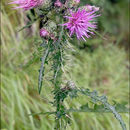Distribution
provided by EOL authors
''Cirsium palustre'' occurs from Lake Baikal in Siberia west to the Baltics and Scandinavia and south through Eastern Europe and as far southwest as the Iberian Peninsula. Disjunctively the species is found in parts of northern Algeria. Specific countries of distribution include Russia, Ukraine, Belarus, Estonia, Latvia, Lithuania, Moldova, Finland, Sweden, Norway, Denmark (including the Faroe Islands), United Kingdom, Ireland, Netherlands, Belgium, Germany, Austria, Poland, Hungary, Romania, Czechoslovakia, Yugoslavia, Albania, Switzerland, Italy, France, Spain and Portugal.
Comprehensive Description
provided by EOL authors
''Cirsium Palustre'' is an extremely spiny thistle that can attain a height of up to two metres. Erect ribbed stems are robust and sturdy, with moderately dense concentrations of spines. The narrow spiky leaves are conspicuously lobed, especially the uppermost; moreover, leaves are near glabrous above, whilst long hairy beneath. Lowest leaves are narrow and elliptical, but the uppermost leaves are lanceolate. Basal rosettes in a colony are so high that they may crowd out competing flora. The species is sexually dimorphic. Marsh Thistle is considered biennial; however, flowering in some habitats does not commence until the plant is five to seven years of age, having strengthened its vegetative stem structure. The discoid flowerheads are one to two centimetres in diameter. Typically a cluster of heads terminate upper stems, with egg-shaped or cylindric involucres being slightly longer than one centimetre. Flower colour exhibits polymorphism, with purple being the most common manifestation; however, white flowering specimens are not uncommon particularly with increasing elevation such as in the Swiss Alps. Outer bracts are frequently sticky and exhibit a pointed spine. Buff coloured achenes are adorned with a luminous apical collar. Each plant may produce up to 2000 seeds, and seeds may result from self or cross-pollination

